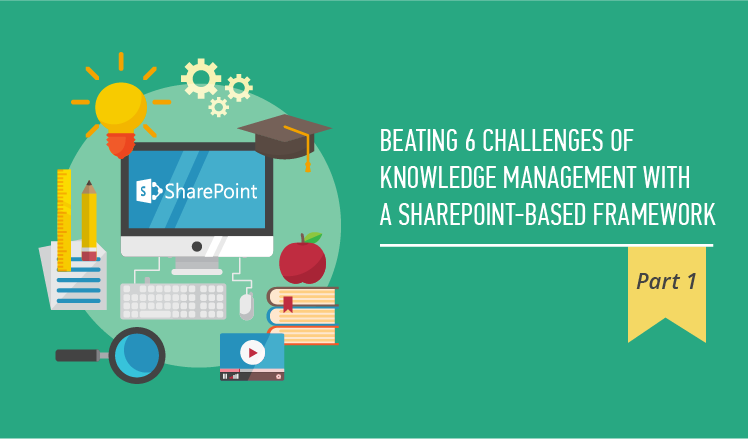Beating 6 challenges of knowledge management with a SharePoint-based framework. Part 1.
Analyzing knowledge management challenges and looking for the ways to solve them, we at ScienceSoft developed our proprietary knowledge management framework. In the first part of this series, we are discussing how the KM framework coupled with Microsoft SharePoint's capabilities can help businesses to manage both explicit and tacit knowledge, make knowledge easily accessible and keep the balance between different models of knowledge distribution.

The current state of knowledge management (KM) looks contradictory. On the one hand, there is a group of world-known business leaders that show outstanding achievements in transforming their knowledge into a profitable resource and a competitive advantage year after year. In the end of 2016, Alphabet, Apple, ConocoPhillips, MITRE, Tesla Motors, IBM, Microsoft and other business giants were named ?leaders in creating organizational intellectual capital and value through the transformation of individual/enterprise knowledge? (2016 Americas Most Admired Knowledge Enterprises report by Teleos).
On the other hand, statistics reveals discouraging facts. The latest survey The State of Knowledge Management 2016-17 published by KMWorld says the transition to fully functioning knowledge management systems is moving at a very moderate pace. At the same time, 38% of organizations don't have any knowledge management solution yet or are still in the exploration stage. To make things worse, 47% of executives and professionals say there is too little understanding of the strategic value of knowledge management. In fact, only 8% of respondents express their satisfaction with the strategic performance of their organization's KM, which means that another 92% are constantly struggling to give their KM projects a positive turn.
All that proves companies may need to find alternative ways of approaching KM. We suggest framing it in a centralized strategy that puts scatted KM efforts together.
Every KM strategy needs to be centralized
Knowledge management is recognized as a driving force of customer satisfaction, enterprise-wide innovations and even the way of reducing operational costs. Yet it can easily fall apart into fragmented, inconsistent efforts where even specialized knowledge management software couldn't save the day any longer.
To put uncoordinated KM efforts back together and create a powerful knowledge management solution, organizations should take a stab at a centralized and well-controlled KM strategy tied to an actionable, clear-cut framework. In this, organizations can rely on the knowledge management framework developed by ScienceSoft. The framework covers all KM aspects and offers relevant Microsoft SharePoint-based solutions to address each particular challenge out there.
Challenge 1: Focusing either on explicit or tacit knowledge only
Putting only explicit knowledge first is one of the most typical mistakes that companies make in trying their hand at KM. Working hard on everything explicit (documented success stories, case studies, best practices, etc.), organizations no longer do KM but mere document management, which is only a part of KM in the true sense of the word. At the same time, prioritizing only tacit knowledge poses the risk that such unrecorded knowledge will get unavailable as soon as a tacit knowledge owner takes a day off or leaves a company.
What the framework suggests: Aligning their KM with the framework, companies get the possibility to pay attention to both explicit and tacit knowledge equally within a single KM system. Firstly, SharePoint's content and document management capabilities ensure well-classified and secure storage of explicit content that is always correlated with knowledge owners. Secondly, a SharePoint-based knowledge management solution becomes a channel for discovering and distributing tacit knowledge as it allows to identify and connect with tacit knowledge owners.
Challenge 2: Leaving no access to knowledge
Corporate knowledge is only valuable when it's available. Unfortunately, important knowledge items and assets quickly get lost in the immense volumes of information generated daily. As a result, employees can hardly find the relevant knowledge when they need it. What's worse, no search option means knowledge stays idle and thus doesn't bring any value to the company.
What the framework suggests: Convenient and pervasive search is the best friend of knowledge. That's why a tuned search, as well as easy access to both explicit and tacit knowledge, is a must. In a SharePoint-based KM system, every piece of explicit knowledge gets searchable by keywords, date, knowledge owner, etc. This allows employees to quickly find a knowledge item/asset, including those located in different environments (through the hybrid search in SharePoint 2016). To find tacit knowledge, employees can identify its owners and contact them in SharePoint immediately even if knowledge owners work in another branch or country.
Challenge 3: Either pushing or pulling
To make knowledge grow, companies should stimulate its acquisition through all possible channels. Often organizations tend to focus on just one possible knowledge distribution model, which is either pull (search) or push (news, tranings, communities of practice). It has to be said that though a finely set search helps employees to solve instant issues, it can't stimulate employees to get additional knowledge. At the same time, passive organizations that don't encourage knowledge exchange come to knowledge stagnation (without trainings, employees don't improve their knowledge) or even 'fermentation? (when new knowledge gets stuck within a particular community of practice and is inaccessible for other employees).
What the framework suggests: The framework helps organizations to keep the balance between different models of knowledge distribution, as well as to decide which model can disseminate versatile knowledge best. For example, the pull mode is optimal for the knowledge fixed in standard corporate policies or guidelines, while the push mode is good for sharing exclusive experience on particular projects. The knowledge of technologies and methodologies applied in the working process should be distributed via both modes to enable its use and accessibility in the long run.
Stay tuned for Part 2 of this series and discover how ScienceSoft's KM framework helps companies to address other KM challenges, thus revealing the true value of corporate knowledge they have on their hands.


